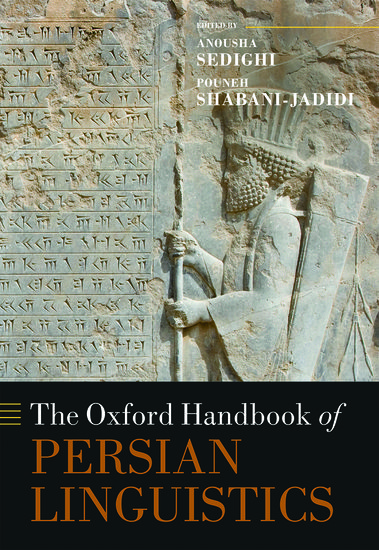 Sedighi, Anousha & Pouneh Shabani-Jadidi (eds.). 2018. The Oxford handbook of Persian linguistics. Oxford University Press.
Sedighi, Anousha & Pouneh Shabani-Jadidi (eds.). 2018. The Oxford handbook of Persian linguistics. Oxford University Press.
This handbook offers a comprehensive overview of the field of Persian linguistics, discusses its development, and captures critical accounts of cutting edge research within its major subfields, as well as outlining current debates and suggesting productive lines of future research. Leading scholars in the major subfields of Persian linguistics examine a range of topics split into six thematic parts. Following a detailed introduction from the editors, the volume begins by placing Persian in its historical and typological context in Part I. Chapters in Part II examine topics relating to phonetics and phonology, while Part III looks at approaches to and features of Persian syntax. The fourth part of the volume explores morphology and lexicography, as well as the work of the Academy of Persian Language and Literature. Part V, language and people, covers topics such as language contact and teaching Persian as a foreign language, while the final part examines psycho- neuro-, and computational linguistics. The volume will be an essential resource for all scholars with an interest in Persian language and linguistics.
Anousha Sedighi is Associate Professor of Persian and Persian Program Head at Portland State University.
Pouneh Shabani-Jadidi is Senior Lecturer in Persian Language and Linguistics and Persian Language Program Head at McGill University
Source: The Oxford Handbook of Persian Linguistics – Anousha Sedighi; Pouneh Shabani-Jadidi – Oxford University Press
 Hoyland, Robert G. 2018. History of the kings of the Persians’ in three Arabic chronicles: The transmission of the Iranian past from late antiquity to early Islam. (Translated Texts for Historians 69). Liverpool: Liverpool University Press.
Hoyland, Robert G. 2018. History of the kings of the Persians’ in three Arabic chronicles: The transmission of the Iranian past from late antiquity to early Islam. (Translated Texts for Historians 69). Liverpool: Liverpool University Press. Tavernier J., Gorris E., Abraham K. & Boschloos V (eds.). 2018.
Tavernier J., Gorris E., Abraham K. & Boschloos V (eds.). 2018.  Miller II, Robert D. 2018.
Miller II, Robert D. 2018. 

 Issue 05 of DABIR (Digital Archive of Brief notes & Iran Review)
Issue 05 of DABIR (Digital Archive of Brief notes & Iran Review) Linduff, Katheryn & Karen Rubinson (eds.). 2018.
Linduff, Katheryn & Karen Rubinson (eds.). 2018.  Zanous, Hamidreza Pasha & Esmaeil Sangari. 2018. The last Sasanians in Chinese literary sources: Recently identified statue head of a Sasanian prince at the Qianling mausoleum.
Zanous, Hamidreza Pasha & Esmaeil Sangari. 2018. The last Sasanians in Chinese literary sources: Recently identified statue head of a Sasanian prince at the Qianling mausoleum.